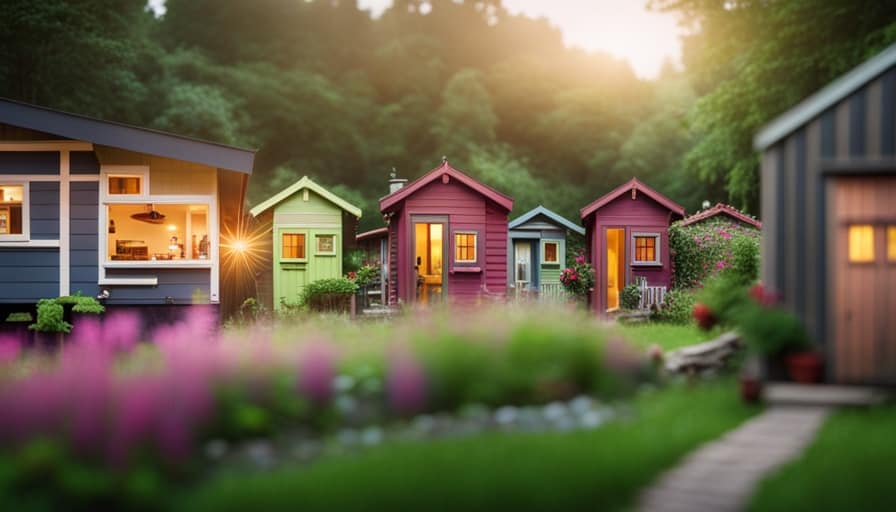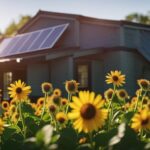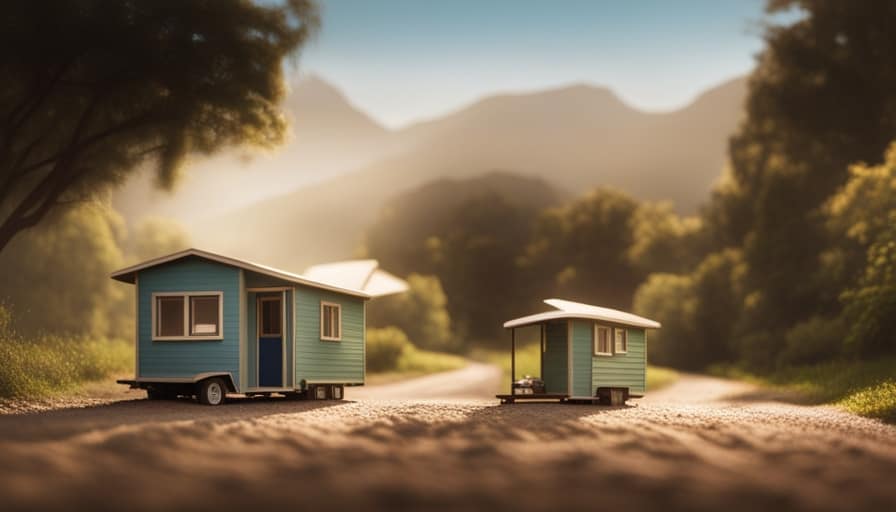As someone who owns a tiny house, I frequently think about the best ways to keep my small home cool. This article will explore different cooling methods to help you stay comfortable and cool during the hot summer months.
From advanced air conditioning systems to clever ventilation strategies, I will explore the ins and outs of cooling your tiny house.
So, let’s dive in and discover the secrets to beating the heat in your tiny oasis.
Key Takeaways
- Geothermal cooling and solar powered cooling are efficient options for cooling a tiny house.
- Ceiling fans and strategic window placement can enhance ventilation and airflow in a tiny house.
- Insulation materials and reflective roofing help maintain a cool interior temperature.
- Using blinds with a high SHGC, insulating window coverings, and exterior shade sails can effectively block out sunlight and regulate temperature in a tiny house.
Efficient Air Conditioning Systems
I’ve found that using one or two efficient air conditioning systems can effectively cool my tiny house.

When it comes to cooling a small space like a tiny house, it’s important to consider energy-efficient options that can provide maximum comfort while minimizing energy consumption. One such option is geothermal cooling, which utilizes the stable temperature of the earth to cool the air. This system works by circulating water through underground pipes, absorbing the heat from the air and releasing it into the ground.
Another option is solar powered cooling, which harnesses the power of the sun to cool the air inside the house. Solar panels collect solar energy, which is then used to power the air conditioning unit.
Ventilation and Airflow Techniques
One effective way to enhance airflow and ventilation in my tiny house is by using a ceiling fan. Ceiling fans are a cost-effective and energy-efficient solution that can help keep the air circulating throughout the space.
To maximize the effectiveness of the ceiling fan, I can also employ cross ventilation techniques. This involves strategically placing windows or vents on opposite sides of the house to create a natural flow of air. By opening these windows or vents, I can allow fresh air to enter and hot air to escape, creating a cooling breeze.

The ceiling fan can then help distribute this fresh air throughout the house, ensuring a comfortable living environment.
Insulation and Reflective Roofing
To effectively cool my tiny house, I can enhance insulation and install reflective roofing.
Insulation is essential in maintaining a comfortable temperature inside the house. By using high-quality insulation materials, such as foam or fiberglass, I can minimize heat transfer and keep the interior cool.
Additionally, reflective roofing can significantly reduce heat absorption from the sun. This type of roofing reflects sunlight instead of absorbing it, helping to prevent heat buildup.

When choosing cooling materials, it’s important to select energy-efficient appliances. Energy Star-rated appliances consume less electricity, reducing the heat generated in the process.
Smart Window Placement and Coverings
Installing blinds and curtains strategically can greatly contribute to the cooling of my tiny house. Here are four ways how:
-
Optimal Window Blinds: Choosing the right window blinds is crucial. Look for blinds with a high Solar Heat Gain Coefficient (SHGC) to block out the sun’s heat effectively. Cellular shades and reflective blinds are excellent options.
-
Insulated Window Coverings: Insulating window coverings like thermal curtains help keep the heat out during hot summer days and retain warmth during colder months.

-
Exterior Shade Sails: Install shade sails on the exterior of your tiny house to block direct sunlight. They provide additional protection and reduce heat gain through windows.
-
Smart Automation: Consider investing in smart blinds that can be programmed to open and close automatically based on the time of day or temperature, maximizing energy efficiency.
Proper window placement and coverings are essential for cooling your tiny house and creating a comfortable living environment. Now let’s explore some natural cooling strategies to further enhance the cooling efficiency.
Natural Cooling Strategies
A few effective ways I can naturally cool my tiny house include utilizing cross ventilation and incorporating shade trees.

Cross ventilation is a passive cooling method that involves strategically placing windows or vents on opposite sides of the house to allow for the flow of cool air. This can be achieved by opening windows or installing vents. By creating a path for air to circulate, hot air can be expelled and replaced with cooler air, creating a more comfortable indoor environment.
Another natural cooling strategy is incorporating shade trees around the house. The trees provide shade, reducing the amount of direct sunlight that enters the house and keeping it cooler.
Additionally, green roof solutions can also help in cooling a tiny house by insulating it and reducing heat absorption.
Frequently Asked Questions
What Are the Different Types of Air Conditioning Systems Suitable for Tiny Houses?
I use portable options and energy efficient solutions to cool my tiny house. There are different types of air conditioning systems suitable for tiny houses, such as mini-split systems and window units.

How Can I Improve the Airflow in My Tiny House Without Relying Solely on Air Conditioning?
Improving ventilation and using natural cooling techniques are effective ways to cool a tiny house without relying solely on air conditioning. By maximizing airflow through strategic placement of windows, doors, and fans, you can maintain a comfortable temperature.
What Are the Best Insulation Materials to Use in a Tiny House to Keep It Cool?
When it comes to keeping my tiny house cool, choosing the right insulation materials is key. Opting for energy efficient options like foam or cellulose insulation can help maintain a comfortable temperature indoors.
Are There Any Specific Window Placement Recommendations to Maximize Natural Cooling in a Tiny House?
To maximize natural cooling in a tiny house, specific window placement recommendations are crucial. Strategic placement of windows can facilitate cross ventilation and airflow, allowing for effective cooling without relying solely on mechanical systems.
What Are Some Creative Ways to Cool a Tiny House Without Relying on Traditional Cooling Systems?
To cool my tiny house, I get creative and think outside the box. I explore alternative cooling methods like using natural ventilation, shading techniques, and energy-efficient cooling options. It’s all about staying cool while saving energy!

Conclusion
In conclusion, cooling a tiny house efficiently requires a combination of smart design choices and natural strategies.
By incorporating efficient air conditioning systems, proper ventilation and airflow techniques, insulation and reflective roofing, as well as strategic window placement and coverings, occupants can create a comfortable living space while minimizing energy consumption.
For instance, a case study showed that by utilizing reflective roofing and insulation, a tiny house in a hot climate was able to maintain a cool indoor temperature without relying heavily on air conditioning.
I’m Theodore, and I love tiny houses. In fact, I’m the author of Tiny House 43, a book about tiny houses that are also tree houses. I think they’re magical places where imaginations can run wild and adventures are just waiting to happen.
While tree houses are often associated with childhood, they can be the perfect adult retreat. They offer a cozy space to relax and unwind, surrounded by nature. And since they’re typically built on stilts or raised platforms, they offer stunning views that traditional homes simply can’t match.
If you’re looking for a unique and romantic getaway, a tree house tiny house might just be the perfect option.
















